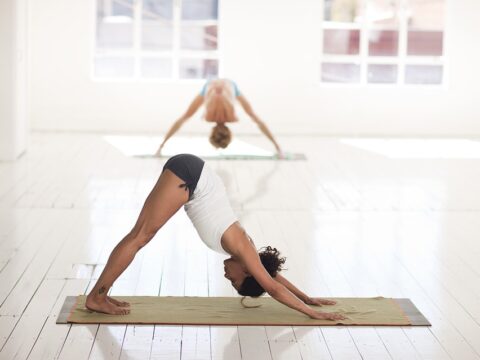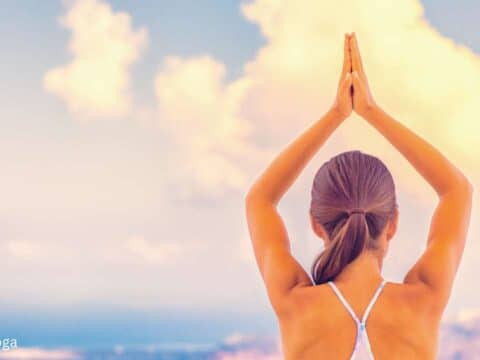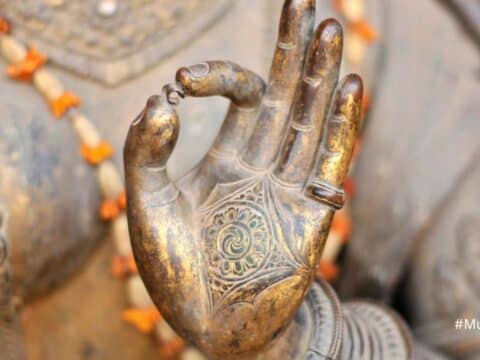Before we look at how often you should practice yoga, let’s take a look at why you should practice yoga. Yoga can improve your mood and help you manage stress better.
It increases serotonin levels in your brain and lowers monoamine oxidase and cortisol levels in your body. It also boosts your confidence, relieves tension and reduces anxiety. You should prioritise your health and well-being by practising yoga.
If you are a complete novice, yoga can seem complicated. You may fall down and sweat and may even have no balance at all. But if you follow along consistently, you will quickly be stronger and more flexible than when you started. And you can even get your friends and family to join in!
Yoga also helps you control your weight and improve your posture. The yoga exercises address every part of the body. This helps you keep your body in balance, which in turn reduces the risk of heart attacks and other types of mental health problems.
In addition, yoga is a great way to manage stress. People who practice yoga regularly are more self-aware and better able to manage their moods and emotions.
It is also a good workout. The ancient art of yoga dates back over 5,000 years. Yoga is not for everyone, but it can be a fun experience and leave you feeling rejuvenated.
Podcast
How often should I practice yoga?
How often should you do yoga? This is a question that many people ask themselves.
It depends on many different factors, such as your age, gender and current lifestyle. But no matter what you do, you will never do enough yoga if you don’t make it a priority.
And why? Because you can learn a lot doing yoga.
Yoga is a great way to relax and improve your fitness level. It also has amazing health benefits and can even help you with certain physical ailments. But all these things are only possible if you practice regularly. You can’t force yourself to get stronger or healthier just by reading about it. You have to do it.
But how often should you do yoga? That is the real question. I think it depends on what you want to achieve.
Let’s look at some of the possible scenarios.
Reducing stress
If you just want to reduce stress, you don’t need to practice yoga as often as if you want to build muscle mass or improve your fitness level. However, if you want to practice yoga regularly, you should try to do it at least twice a week.
Muscle building
If you want to build muscle mass, then you probably need to do more. For example, if you want to do strength training, you probably need to practice yoga at least twice a week.
Improve flexibility
If you want to improve your flexibility, you should practice yoga three times a week.
Loose weight
Iif you want to lose weight, you need to practise yoga more than once a week. However, if you want to gain weight, you probably need to practice less.
There are so many reasons why we give up things we have started. We fail to stick with it for various reasons. But even if you don’t succeed, there are still ways to stay motivated and keep your spirits up. The best thing is to talk to your yoga teacher.
How to design your yoga routine
What’s the first thing that comes to mind when you hear “yoga”? The answer probably has nothing to do with stretching, although yoga certainly has a lot to do with it. Instead, when you hear the word, you probably think of poses, meditation and a lot of time. But in reality, yoga is much more than poses and meditation. Yoga is a way of life.
In fact, yoga is a complete way of life. And the best part is that it doesn’t take much time to achieve the benefits. All you need to do is spend a few minutes each day doing simple stretching and breathing exercises.
How to do yoga easily?
Let’s first talk about the yoga postures. To be able to perform a yoga posture, you should first make sure that your body is flexible. So start with simple stretching exercises. For example, you can stretch your legs straight, stretch your arms straight or do any other type of stretching exercise that you know you can do.
Once you are done with the basic stretches, you can move on to a yoga pose. While there are many different types of yoga poses, some are easier than others. The easiest ones include twists and simple backbends. However, if you want to practice more advanced yoga poses, you may need to invest a little more time and energy.
However, you don’t have to be a yoga expert to practise yoga. All you need is a yoga mat and the motivation to practice for at least five minutes every day. That’s all you need to reap the health and mental benefits that yoga has to offer.
Benefits of yoga for your health
Yoga is a great way to relieve stress, improve your mood and boost your energy. It’s also a great workout because it burns calories, boosts your metabolism and strengthens your muscles. However, all these benefits only apply to those who actually practice yoga.
If you are not yet practising yoga, you should start today. You will find that you feel happier and more energetic after just a few minutes of practice. So start with a simple yoga pose. Once you enjoy the benefits, you can move on to more advanced poses.
And if you feel a little sore after a yoga pose, don’t worry. Just relax, breathe and let your body heal itself.
How do I decide what kind of yoga to practise?
First of all, you should think about what you want to achieve with yoga. This will determine what kind of yoga you should practise. Also think about your physical limitations, your time and your financial possibilities.
If you take a few yoga classes before making a final decision, you can make the most of your experience. There are many different styles of yoga, so you should be able to find one that suits your needs.
You should consider the pace and intensity of the yoga class you will be taking. Some styles are more intense and difficult than others. If you are a beginner, you should look for a class that is gentle and easy to follow. This will allow you to familiarise yourself with the yoga postures before moving on to more challenging classes.
Also, many yoga styles have commonalities, such as a warm-up, focused postures and flow. But like dating, it’s important to find the right yoga style for you. Hopefully you will find the perfect yoga style for you and have an enjoyable practice.
You can practice a spiritual style of yoga like Kundalini, which is based on chanting and meditation. This type of yoga focuses on awakening the Kundalini energy through repetitive postures, breath work and meditation. This type of yoga can be very intense and you should choose it carefully.
Vinyasa, or “flow” yoga, is a more dynamic style of yoga that focuses on the connection between movement and breath. Vinyasa classes are usually more physically demanding and push you to your limits. This style of yoga is ideal for people who love HIIT workouts. It is also good for endurance athletes and people who train intensively.
If you’re not sure what you’re looking for in a yoga class, try Ashtanga yoga. This energetic style of yoga was developed in the 20th century by K. Pattabhi Jois. The technique uses a fast flow between poses and is known to increase the heart rate.
If you are new to yoga, you should get to know the different branches of yoga. Hatha yoga, for example, is mostly about physical poses. It can purify the body and prepare you for meditation. This type of yoga is also gentle, which makes it a good option for beginners.
Yin yoga, on the other hand, is a slower, more meditative practice. It emphasises stretches and strengthens connective tissues throughout the body. It is also an excellent option for beginners as it is easy to follow but can be challenging at the same time.
What do you get out of yoga?
Yoga is a great way to relax and relieve stress. The postures and breath work activate the parasympathetic nervous system, which reminds the body to relax.
It also helps the body release muscle tension, which is good for the body and mind. In addition to stretching the muscles, yoga classes can also help loosen and strengthen your joints. If you are practising yoga for the first time, the teacher can help you find the poses that are right for you.
While yoga is not a substitute for aerobic exercise such as running or cycling, it is still good for your overall fitness. As yoga increases your heart rate, it strengthens your heart and improves your fitness. Even a ten or fifteen minute yoga practice can help you feel better. Once you see the first results, you will be motivated to keep practising.
Yoga poses can improve your mood immediately. According to Robin Berzin, founder of Parsley Health, some yoga poses are particularly beneficial for people suffering from depression. She recommends the camel pose and the pigeon pose, which open the heart. This increases your mental focus and helps improve your ability to learn, retain and update information.
Many studies have shown that yoga is effective in fighting depression. Experts recommend practising yoga at least twice a week for best results. It is also a great way to improve your sleep quality and rest.
As most of you probably know, yoga is a great workout that can improve your strength, flexibility, mental focus and more. But there’s so much more to it than just stretching and breathing.
In fact, yoga can help you improve your life in every single area of your life. It helps you in your relationships, improves your overall health, helps you maintain your weight, strengthens your bones and so much more.
6 Ways to incorporate yoga into your daily life.
Let’s get started!
Yoga poses for sleep
Yoga can be a great way to relax and wind down at night. But one of the most important poses is known as “savasana”. This is a pose that you should do at the end of the day. In this pose you should lie down and relax.
The warrior pose
If you are feeling stressed and overwhelmed, this is a great pose to help you calm down and release tension. You can do this pose by standing up and placing your hands on your hips. Then move your feet backwards until you feel a slight stretch in your lower back.
The bridge pose
This is another great pose to help you relieve stress and release tension. You can do this pose by standing on one foot. Then bend forward and lift the other leg behind you.
The child pose
This is one of the most important poses for pregnant women. You can do this pose by lying on your back and lifting your knees. This will promote blood circulation in your body.
The bow pose
Another great pose for stress relief is the bow pose. You can do this pose by bending your arms at a 90-degree angle and then slowly lowering yourself to the floor.
The reclined tiger pose
This is another great pose for relaxation. In this pose you lie on your back, bend your knees and raise your arms above your head.




